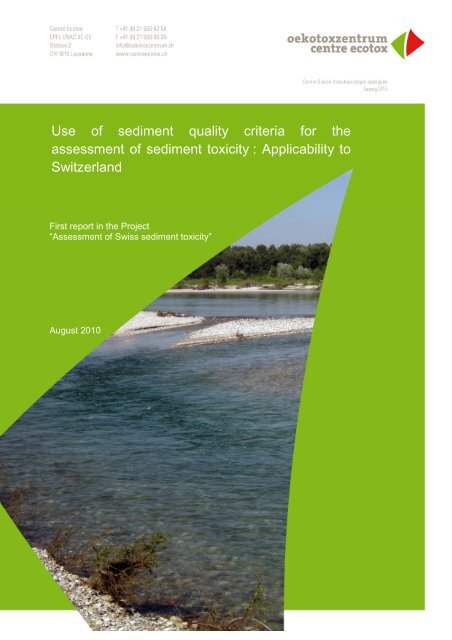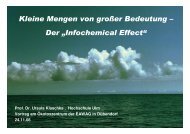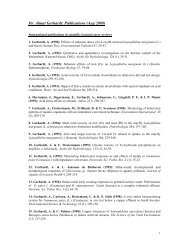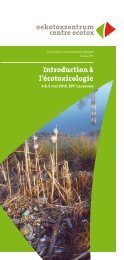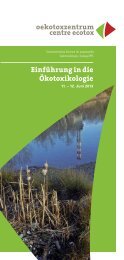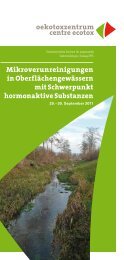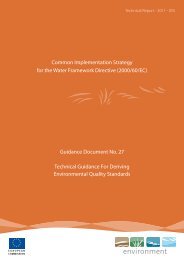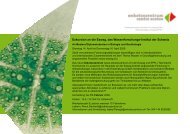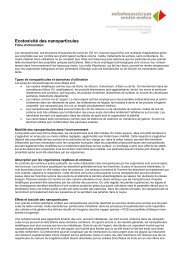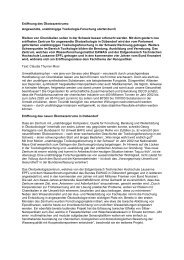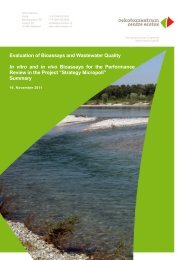Use of sediment quality criteria for the assessment ... - Oekotoxzentrum
Use of sediment quality criteria for the assessment ... - Oekotoxzentrum
Use of sediment quality criteria for the assessment ... - Oekotoxzentrum
You also want an ePaper? Increase the reach of your titles
YUMPU automatically turns print PDFs into web optimized ePapers that Google loves.
<strong>Use</strong> <strong>of</strong> <strong>sediment</strong> <strong>quality</strong> <strong>criteria</strong> <strong>for</strong> <strong>the</strong><br />
<strong>assessment</strong> <strong>of</strong> <strong>sediment</strong> toxicity : Applicability to<br />
Switzerland<br />
First report in <strong>the</strong> Project<br />
“Assessment <strong>of</strong> Swiss <strong>sediment</strong> toxicity”<br />
August 2010
Project Team<br />
R. FLÜCK<br />
Centre Suisse d’écotoxicologie appliquée Eawag/EPFL<br />
EPFL-ENAC-IIE-GE, Station 2 (GR B0 391). CH-1015 Lausanne<br />
+41 (0)21 693 37 85. rebecca.flueck@oekotoxzentrum.ch<br />
S. CAMPICHE<br />
Centre Suisse d’écotoxicologie appliquée Eawag/EPFL<br />
EPFL-ENAC-IIE-GE, Station 2 (GR B0 391). CH-1015 Lausanne<br />
+41 (0)21 693 62 58. sophie.campiche@oekotoxzentrum.ch<br />
N. CHÈVRE<br />
IMG-CAM - Faculté des Géosciences et de l'environnement<br />
Université de Lausanne, Anthropole 1124. CH-1015 Lausanne<br />
+41 (0)21 692 3557. nathalie.chevre@unil.ch<br />
F. DE ALENCASTRO<br />
EPFL ENAC IIE GR-CEL GR A1 382 Station 2<br />
CH-1015 Lausanne<br />
+41 (0)21 693 27 29. felippe.dealencastro@epfl.ch<br />
B. FERRARI<br />
Cemagref - Laboratoire d'écotoxicologie<br />
3 bis, quai Chauveau. F-69336 Lyon Cedex 9<br />
+33 (4)72 20 86 24. benoit.ferrari@cemagref.fr<br />
S. SANTIAGO<br />
Soluval Santiago<br />
Rue Edouard-Dubied 2. CH-Couvet<br />
+41 (0)32 863 43 60. ssantiago@bluewin.ch
Foreword<br />
Both river and lake <strong>sediment</strong>s are important compartments <strong>of</strong> <strong>the</strong> aquatic ecosystems as <strong>the</strong>y<br />
provide habitat and shelter <strong>for</strong> many organisms. However, <strong>sediment</strong>s also act as a long-term source<br />
<strong>of</strong> contamination, as pollutants can be temporarily unavailable <strong>for</strong> uptake when bound to particles<br />
and so gradually released to <strong>the</strong> aquatic phase. Many benthic and epibenthic organisms which<br />
represent much <strong>of</strong> <strong>the</strong> lower trophic levels may <strong>the</strong>n be exposed to <strong>the</strong>se substances. Adverse<br />
effects such as changes in benthic community structure or population decline have been reported. In<br />
Switzerland, <strong>sediment</strong>s are considered as part <strong>of</strong> <strong>the</strong> surface waters. According to <strong>the</strong> Ordinance on<br />
waters protection (OEaux, 1998), <strong>sediment</strong>s should not accumulate any persistent pollutants in order<br />
to protect <strong>the</strong> aquatic life. However, contaminants analyses and studies on <strong>the</strong>ir toxicity potential are<br />
not <strong>of</strong>ten undertaken. In addition, recommendations <strong>for</strong> <strong>the</strong> characterisation <strong>of</strong> <strong>sediment</strong> are lacking<br />
and <strong>quality</strong> <strong>criteria</strong> missing.<br />
The present document is <strong>the</strong> first step <strong>of</strong> a project aiming at elaborating recommendations <strong>for</strong> <strong>the</strong><br />
<strong>assessment</strong> <strong>of</strong> <strong>sediment</strong> toxicity in Switzerland. We would like to present here a review and syn<strong>the</strong>sis<br />
<strong>of</strong> <strong>the</strong> current methods used in Europe and worldwide <strong>for</strong> <strong>the</strong> <strong>assessment</strong> <strong>of</strong> <strong>sediment</strong> <strong>quality</strong> as well<br />
as some example <strong>of</strong> values to illustrate this point. This document aims to provide a basis <strong>for</strong><br />
discussion to help experts and stakeholders taking decisions regarding <strong>the</strong> choice and applicability <strong>of</strong><br />
<strong>sediment</strong> <strong>quality</strong> <strong>criteria</strong> to Switzerland. The proposed approach mainly refers here to <strong>sediment</strong> in<br />
situ characterisation and does not aim at discussing <strong>sediment</strong> management in details <strong>for</strong> <strong>the</strong><br />
moment, which can be <strong>the</strong> purpose <strong>of</strong> a next document.<br />
Centre Ecotox Eawag/EPFL 2010<br />
1
Index<br />
Foreword<br />
…………………………………………..…...1<br />
I- Background …………………………………………..…...3<br />
i. Introduction …………………………………………..…...3<br />
ii. Problem Statement<br />
iii. Aim <strong>of</strong> <strong>the</strong> project<br />
…………………………………………..…...3<br />
…………………………………………..…...5<br />
II. Sediment <strong>quality</strong> <strong>criteria</strong>: state-<strong>of</strong>-<strong>the</strong>-art<br />
…………………………………………..…...6<br />
i. Methods <strong>of</strong> derivation …………………………………………..…...6<br />
The background level and reference condition approaches………………………………6<br />
The <strong>the</strong>oretical approach: equilibrium partitioning ………………………………6<br />
The effects-doses relationships approach …………………………………………..…...7<br />
The <strong>assessment</strong> factors approach …………………………………………..…...8<br />
The consensus approach<br />
…………………………………………..…...8<br />
The harmonised European approach within <strong>the</strong> Water Framework Directive…………..8<br />
ii. Practical use <strong>of</strong> <strong>sediment</strong> <strong>quality</strong> <strong>criteria</strong><br />
…………………………………………..…...9<br />
III. Sediment <strong>quality</strong> <strong>criteria</strong>: example <strong>of</strong> values<br />
……………………………………………...10<br />
IV. Discussion, conclusion and perspectives<br />
……………………………………………...11<br />
References<br />
……………………………………………...16<br />
List <strong>of</strong> figure and tables:<br />
Figure1: Holistic approach <strong>for</strong> <strong>sediment</strong> <strong>quality</strong> <strong>assessment</strong> and associated possibilities <strong>of</strong> application ...…...5<br />
Table 1: List <strong>of</strong> principal <strong>sediment</strong> <strong>quality</strong> <strong>criteria</strong> used Europe or world –wide. ……………………13<br />
Table 2: Examples <strong>of</strong> <strong>sediment</strong> <strong>quality</strong> <strong>criteria</strong> values. ……………………………………………...14<br />
Table 3: Examples <strong>of</strong> measured concentrations in Switzerland. ………………..……………………15<br />
Centre Ecotox Eawag/EPFL 2010<br />
2
I- I. Background<br />
i. Introduction<br />
Sediments are deposits found at <strong>the</strong> bottom <strong>of</strong> aquatic environments. They are made up <strong>of</strong> particular matters<br />
which are <strong>of</strong> different size, <strong>for</strong>m and mineralogical composition. These matters can originate ei<strong>the</strong>r from soil<br />
particles transported by fluvial processes, run<strong>of</strong>f and wind (terrigenous <strong>sediment</strong>), or <strong>the</strong>y can result from<br />
decomposition <strong>of</strong> organisms’ debris (organogenous or biogenous <strong>sediment</strong>). In addition, <strong>sediment</strong> particles<br />
present variability in grain-size; <strong>the</strong> size fraction larger than sand, which measures between 0.02 and 0.20 mm,<br />
is collectively called gravel and <strong>the</strong> size fraction smaller than sand (silt and clay) is collectively called mud. This<br />
size variability will explain <strong>the</strong> repartition <strong>of</strong> <strong>the</strong> particles within a river flow. Indeed <strong>sediment</strong> particles can be<br />
ei<strong>the</strong>r in <strong>the</strong> flow as suspended matter because <strong>of</strong> important upwards velocity or deposited if <strong>the</strong> settling<br />
velocity is stronger. As certain chemicals can adsorb to particular matter, <strong>the</strong>y will also be found in <strong>the</strong>se<br />
different locations. Consequently aquatic life may be affected by contaminants though <strong>sediment</strong> contact and/or<br />
ingestion and interstitial or surface water contact or uptake. Chemicals in suspended matter represent generally<br />
<strong>the</strong> current pollution whereas <strong>the</strong> deeper layers <strong>of</strong> <strong>sediment</strong> stand <strong>for</strong> <strong>the</strong> historical contamination. The first<br />
layers <strong>of</strong> <strong>sediment</strong> seems <strong>the</strong>n to be <strong>the</strong> most relevant part to assess as it accounts <strong>for</strong> newly deposited matter<br />
which will be <strong>the</strong> major feeding source and/or contact substrate <strong>for</strong> <strong>sediment</strong>-dwelling organisms.<br />
Sediment, which shows variability in time and space, is thus an essential, integral and dynamic part <strong>of</strong> our river<br />
basins (SedNet, 2006) because <strong>of</strong> its role <strong>of</strong> both shelter <strong>for</strong> many organisms and long-term source <strong>of</strong><br />
pollutants. It is part <strong>of</strong> <strong>the</strong> water continuum and should not be neglected as its pollution 1 can be source <strong>of</strong><br />
deleterious pressures that have to be considered in <strong>the</strong> monitoring <strong>of</strong> aquatic ecosystems.<br />
ii. Problem statement<br />
Nowadays, <strong>sediment</strong> <strong>quality</strong> <strong>assessment</strong> methods used in Europe and worldwide, mainly rely on a chemical<br />
approach, i.e. total environmental concentrations are measured (concentrations can also be predicted) and<br />
<strong>the</strong>n compared to available reference, target, recommended or <strong>quality</strong> values.<br />
In Switzerland <strong>the</strong>re are still no trigger values on pollutants in <strong>sediment</strong>s and <strong>the</strong>re is only little systematic<br />
analysis <strong>of</strong> <strong>the</strong> <strong>sediment</strong> load, which complicates <strong>the</strong> definition and identification <strong>of</strong> polluted river sections<br />
(BMG, 2007). Never<strong>the</strong>less, some <strong>sediment</strong> contamination studies have been reported and <strong>the</strong> following<br />
examples can be cited:<br />
- The famous accident <strong>of</strong> <strong>the</strong> “Schweizerhalle” in Basel in 1986 caused important Hg and Cd<br />
contamination in <strong>the</strong> Rhine, although <strong>the</strong> situation seems to have improved much.<br />
- Rivers close to shooting ranges can show heavy lead and antimony pollution (Umwelt Aargau N°37,<br />
2007). Decontamination actions and enhancement <strong>of</strong> <strong>the</strong>se infrastructures have been undertaken to<br />
find a solution <strong>for</strong> this kind <strong>of</strong> problem.<br />
- According to a publication <strong>of</strong> <strong>the</strong> Office <strong>for</strong> Water from canton Zürich about water <strong>quality</strong> <strong>of</strong> lakes,<br />
surface and underground waters, <strong>sediment</strong>s present important contamination with Cu and Zn.<br />
- The International Commission <strong>for</strong> <strong>the</strong> Protection <strong>of</strong> Lake Geneva (CIPEL) and <strong>the</strong> Forel Institute<br />
(University <strong>of</strong> Geneva) showed that <strong>the</strong> Vidy Bay, in Lausanne, is highly contaminated by heavy metals<br />
(www.cipel.org).<br />
1 We usually talk about contamination when chemicals found in <strong>the</strong> <strong>sediment</strong> are not usually found <strong>the</strong>re or when <strong>the</strong>y are found in higher<br />
quantities than natural background concentrations. Contamination can be distinguished from <strong>the</strong> word pollution which is used when<br />
<strong>sediment</strong> contamination results in deleterious biological effects (according to Chapman, 2007).<br />
Centre Ecotox Eawag/EPFL 2010<br />
3
- Sediments <strong>of</strong> hydroelectric plants reservoirs, like <strong>for</strong> example in <strong>the</strong> site <strong>of</strong> Verbois on <strong>the</strong> Rhône (GE),<br />
are monitored in term <strong>of</strong> quantity but also in term <strong>of</strong> <strong>quality</strong>. In case <strong>of</strong> an evacuation need, toxicity<br />
potential associated to metallic pollution <strong>of</strong> <strong>sediment</strong>s may be investigated (www.rhone-geneve.ch, and<br />
Institut Forel, 2003, 2010). Sediments <strong>of</strong> dams’ reservoirs have also been investigated downstream<br />
from urban areas (Wildi et al., 2004) showing high metal contamination.<br />
Currently, <strong>the</strong> emphasis seems thus to be put on heavy metal compounds although Switzerland should also<br />
demonstrate interest in organic substances, that can be found in <strong>sediment</strong>s, as <strong>the</strong> country signed <strong>the</strong><br />
Convention <strong>of</strong> Stockholm on persistent organic pollutants (POPs) 2 . Some examples on polycyclic aromatic<br />
hydrocarbons (PAHs) and polychlorinated biphenyls (PCBs) <strong>sediment</strong> contaminations can be found anyway. As<br />
an example we can cite PCBs pollution in <strong>the</strong> River Sarine, where in 2008 measurement <strong>of</strong> 53 <strong>sediment</strong><br />
samples gave a mean value <strong>of</strong> 1.34 mg/kg (sum <strong>of</strong> 6 PCBs). In Fribourg, <strong>the</strong> dump site <strong>of</strong> “La Pila” is an<br />
important source <strong>of</strong> POPs, namely PCBs in <strong>the</strong> Birse River. Associated to this pollution, fish were found to<br />
accumulate PCBs in <strong>the</strong>ir cells which can represent a hazard when <strong>the</strong>y are consummated (Schmidt et al.,<br />
2010). Within new emerging substances, nanoparticles could be interesting to consider because <strong>the</strong>se<br />
chemicals could present toxicity risk as <strong>the</strong>y are said to be trapped in <strong>sediment</strong> particles.<br />
This lack <strong>of</strong> trigger values to assess <strong>sediment</strong> <strong>quality</strong> is maybe resulting from <strong>the</strong> fact that no true legal base<br />
regarding <strong>sediment</strong> protection has yet been decreed in Switzerland, as it is already <strong>the</strong> case, <strong>for</strong> over a decade,<br />
in <strong>the</strong> water, <strong>for</strong> heavy metals and pesticides (OEaux, 1998) and in <strong>the</strong> soil compartment <strong>for</strong> heavy metals<br />
(OSol, 1998). Despite this lack <strong>of</strong> a proper legislation, <strong>sediment</strong> and suspended matter are mentioned in <strong>the</strong><br />
Ordinance <strong>of</strong> Waters Protection (OEaux, 1998). O<strong>the</strong>r texts, like <strong>the</strong> Ordinance on waste treatment (OTD,<br />
1990), Dredging <strong>of</strong> lake <strong>sediment</strong>s in harbours and waterways (1995), Ordinance on soil protection (OSol,<br />
1998) and Directive on excavations materials (1999) focus principally <strong>the</strong> management <strong>of</strong> <strong>sediment</strong>s. They<br />
present recommendations in term <strong>of</strong> <strong>the</strong> “future” <strong>of</strong> <strong>sediment</strong>s, when considered as a waste or excavation<br />
material. Indeed, objective or <strong>quality</strong> values are given in OSol (soil indicative values) and <strong>the</strong> Directive on<br />
excavations materials (U- and T-values), which are regularly used to assess <strong>the</strong> pollution <strong>of</strong> <strong>sediment</strong>s, and<br />
which mainly help in decision making concerning <strong>sediment</strong> management, like <strong>sediment</strong> dredging. There is <strong>the</strong>n<br />
an obvious lack in adequate values <strong>for</strong> in situ <strong>sediment</strong> characterisation.<br />
Actually, some <strong>quality</strong> <strong>criteria</strong> <strong>for</strong> in situ <strong>sediment</strong> characterisation are currently used in Switzerland, like <strong>the</strong><br />
reference objectives <strong>of</strong> <strong>the</strong> International Commission <strong>for</strong> <strong>the</strong> Protection <strong>of</strong> <strong>the</strong> Rhine (ICPR). These references<br />
objectives exist <strong>for</strong> 6 metals (Cd, Cu, Hg, Ni, Pb and Zn) in <strong>sediment</strong> or suspended matter whereas <strong>for</strong> organic<br />
pollutants (Benzo(a)pyren, HCB, PCB 153 and sum <strong>of</strong> 7 PCBs) values have been derived from reference<br />
objectives fixed <strong>for</strong> <strong>the</strong> water compartment. As long as <strong>the</strong> values <strong>of</strong> references objectives are not exceeded,<br />
<strong>the</strong> protection <strong>of</strong> aquatic life, water supply, human fish consumption and <strong>the</strong> use <strong>of</strong> Rhine <strong>sediment</strong>s are<br />
guaranteed (CIPR, 2003). ICPR values are routinely applied, but only by cantons within <strong>the</strong> Swiss Rhine<br />
watershed, as a comparison to measured environmental concentrations. Measured environmental<br />
concentrations are also <strong>of</strong>ten compared with <strong>the</strong> “Swiss rivers median concentrations” which are median<br />
contaminant concentrations in <strong>sediment</strong>s (fine particles
iii. Aim <strong>of</strong> <strong>the</strong> project<br />
The use <strong>of</strong> <strong>quality</strong> <strong>criteria</strong> to assess <strong>sediment</strong> toxicity could represent a simple and time effective tool <strong>for</strong> canton<br />
regulators <strong>for</strong> <strong>the</strong> interpretation <strong>of</strong> measured environmental concentrations. However, as noticed previously,<br />
and more examples will be given below, several <strong>quality</strong> <strong>criteria</strong> exist and/or are already used in Switzerland.<br />
There is thus a need to fixedly define values, <strong>the</strong> most pertinent, to refer to, so that harmonisation in<br />
Switzerland is obtained <strong>for</strong> this point. To help in this way, this present document gives a worldwide overview<br />
and a discussion <strong>of</strong> <strong>the</strong> diversity <strong>of</strong> existing methods used <strong>for</strong> <strong>the</strong> definition <strong>of</strong> <strong>the</strong>se values (Parts II. and IV.,<br />
respectively). A comparison between values was also realised (Part III.). This state-<strong>of</strong>-<strong>the</strong>-art will hopefully<br />
provide a basis <strong>for</strong> discussion to help experts and stakeholders taking decisions regarding <strong>the</strong> choice and<br />
applicability <strong>of</strong> <strong>sediment</strong> <strong>quality</strong> <strong>criteria</strong> to Switzerland.<br />
At this step, it is important to distinguish two kinds <strong>of</strong> approaches concerning <strong>sediment</strong> <strong>quality</strong> <strong>assessment</strong>:<br />
<strong>sediment</strong> management and <strong>sediment</strong> “compliance checking”. The first approach aims at characterising<br />
<strong>sediment</strong> pollution in order to take a decision in its dredging and/or treatment or predict impacts <strong>of</strong> dredging or<br />
dilution (e.g. values used <strong>for</strong> excavation materials or OSol indicative values). The second approach aims at<br />
characterising in situ <strong>sediment</strong>s and should be included in <strong>the</strong> monitoring <strong>of</strong> surface waters, as evaluation <strong>of</strong><br />
<strong>sediment</strong> toxicity could bring useful in<strong>for</strong>mation <strong>for</strong> <strong>the</strong> understanding <strong>of</strong> hazard to aquatic ecosystems.<br />
The present document principally focuses on in situ <strong>sediment</strong> characterisation using <strong>sediment</strong> <strong>quality</strong> <strong>criteria</strong><br />
(Figure 1, grey-highlighted cells). Fur<strong>the</strong>r discussions on sampling strategies, applying <strong>of</strong> bioassays and<br />
biological indexes, worldwide recognised as beneficial <strong>for</strong> <strong>assessment</strong>, will follow in fur<strong>the</strong>r documents, aiming<br />
at finally making available recommendations on how to globally evaluate and characterise <strong>sediment</strong>s in term <strong>of</strong><br />
chemical exposition hazard and toxic effects on benthic organisms.<br />
Triad approach 3 <strong>for</strong> <strong>the</strong> <strong>assessment</strong> <strong>of</strong> <strong>sediment</strong> <strong>quality</strong><br />
Physical and chemical<br />
characterisation<br />
Analysis <strong>of</strong> chemical concentrations<br />
in whole <strong>sediment</strong> and comparison<br />
to a <strong>quality</strong> criterion.<br />
Grain-size (silt, clay, sand)<br />
Total organic carbon<br />
Bioavailability...<br />
Compliance checking in aquatic<br />
ecosystems monitoring<br />
Biological surveys<br />
<strong>Use</strong> <strong>of</strong> biological indexes:<br />
- Standard Global Biological<br />
Index<br />
- IOBS Index (Oligochetae<br />
communauty index)<br />
- MakroIndex (Cf. Swiss Modular<br />
Stepwise Procedure)…<br />
Sampling strategies<br />
(Manipulation, pre-treatment, storing, conservation…)<br />
Possibilities <strong>of</strong> application<br />
Ecotoxicological tests<br />
Depending on <strong>the</strong> studied fractions,<br />
bioassays can be used:<br />
- Whole <strong>sediment</strong>: C. riparius<br />
(Insect), H. azteca (Crustacean)<br />
- Sediment extracts: V. fischeri<br />
(Bacteria), D. magna (Crustacean)…<br />
Also possible in situ.<br />
Management <strong>of</strong> <strong>sediment</strong>s<br />
Figure 1: Holistic approach <strong>for</strong> <strong>sediment</strong> <strong>quality</strong> <strong>assessment</strong> and associated possibilities <strong>of</strong> application.<br />
3 The triad approach, which was first proposed by Chapman, 1990, aims at ga<strong>the</strong>ring several lines <strong>of</strong><br />
investigations to assure pro<strong>of</strong> <strong>of</strong> evidence in <strong>sediment</strong> <strong>quality</strong> <strong>assessment</strong>.<br />
Centre Ecotox Eawag/EPFL 2010<br />
5
II- Sediment <strong>quality</strong> <strong>criteria</strong>: state-<strong>of</strong>-<strong>the</strong>-art<br />
Sediment <strong>quality</strong> <strong>criteria</strong> are numerical chemical concentrations intended to be ei<strong>the</strong>r protective to biological<br />
resources or predictive <strong>of</strong> adverse effects to those resources, or both (Wenning et al., 2005). In o<strong>the</strong>r words,<br />
<strong>the</strong>y provide scientific benchmarks, or reference points, <strong>for</strong> evaluating <strong>the</strong> potential <strong>for</strong> observing adverse<br />
biological effects in aquatic systems (CCME, 1999). Sediment <strong>quality</strong> <strong>criteria</strong> can be used <strong>for</strong> example to<br />
classify <strong>sediment</strong> samples with regard to <strong>the</strong>ir toxic potential, identify problematic contaminants, put priorities<br />
on areas, based on <strong>the</strong> frequency and degree <strong>of</strong> which values are exceeded.<br />
i. Methods <strong>of</strong> derivation<br />
The overview <strong>of</strong> <strong>sediment</strong> <strong>quality</strong> <strong>criteria</strong> in Europe and fur<strong>the</strong>r in<strong>for</strong>med us that harmonisation is lacking and<br />
that <strong>the</strong> existence <strong>of</strong> different <strong>sediment</strong> <strong>quality</strong> <strong>criteria</strong> is mainly due to <strong>the</strong> existence <strong>of</strong> diverse methods <strong>of</strong><br />
derivation. Most <strong>of</strong> <strong>the</strong> current used <strong>sediment</strong> <strong>quality</strong> <strong>criteria</strong>, which are defined <strong>for</strong> a region, a country or in<br />
case <strong>of</strong> international commissions, can be found in Table 1. Among <strong>the</strong>se <strong>criteria</strong>, different derivation methods<br />
have been noticed and are detailed below.<br />
The background level and reference condition approaches<br />
The background level approach gives median concentration according to <strong>the</strong> geochemistry <strong>of</strong> an area. This<br />
was historically <strong>the</strong> first method used to derive <strong>sediment</strong> <strong>quality</strong> <strong>criteria</strong>. Data on geochemical background are<br />
usually easily available and can be found <strong>for</strong> example on <strong>the</strong> website <strong>of</strong> <strong>the</strong> Forum <strong>of</strong> <strong>the</strong> European Geological<br />
Surveys (FOREGS; http://www.gtk.fi/publ/<strong>for</strong>egsatlas/index.php, 2010), where a geochemical atlas <strong>of</strong> Europe<br />
gives measured concentrations <strong>of</strong> metallic trace elements. Values <strong>for</strong> Switzerland are <strong>for</strong> example <strong>of</strong> 22.9 +/-<br />
7.8 mg/kg dry weight (mean +/- standard deviation) <strong>for</strong> Ni, 17.9 +/- 7.4 <strong>for</strong> Cu and 80.1 +/- 59.5 <strong>for</strong> Zn (10<br />
sampling points).<br />
As an example <strong>of</strong> application, background concentration is taken into account <strong>for</strong> metals in Europe in <strong>the</strong><br />
development <strong>of</strong> Environmental Quality Standards <strong>for</strong> <strong>sediment</strong>s (QS sed ). QS sed equals background<br />
concentration added to a Maximum Permissible Addition (MPA) which is derived through a <strong>the</strong>oretical or<br />
empirical method (see below).<br />
Close to this approach, <strong>the</strong> so-called reference condition approach is, or was widely used in Europe; reference<br />
values are measured in non polluted reference sites. In Belgium, <strong>for</strong> example, <strong>the</strong> Flemish Environmental<br />
Protection Agency published reference values (RV). These reference values are means <strong>of</strong> environmental<br />
concentrations (<strong>for</strong> metals, sum <strong>of</strong> PAHs and PCBs, non-polar hydrocarbons…) measured in 12 sites being<br />
part <strong>of</strong> a monitoring program (every four years) and which have been chosen <strong>for</strong> <strong>the</strong>ir good biological status.<br />
Examples <strong>of</strong> some environmental concentrations measured in Swiss rivers or lakes <strong>sediment</strong>s can be found in<br />
Table 3.<br />
The <strong>the</strong>oretical approach: equilibrium partitioning<br />
The equilibrium partitioning method is <strong>of</strong>ten used to calculate <strong>the</strong> exposition to and <strong>the</strong> effects <strong>of</strong> chemicals on<br />
organisms based on water phase concentrations when toxicity data on dwelling organisms are very limited<br />
(OECD, 1992). Indeed this method is generally used as it is <strong>the</strong> only way to have prediction on toxicity when no<br />
or very few ecotoxicity data exist <strong>for</strong> <strong>the</strong> assessed substance. This <strong>the</strong>oretically-based approach uses <strong>the</strong><br />
hypo<strong>the</strong>sis <strong>of</strong> <strong>the</strong> existence <strong>of</strong> an equilibrium in <strong>the</strong> distribution <strong>of</strong> contaminants between <strong>the</strong> 3 main phases:<br />
interstitial water, <strong>sediment</strong> / suspended matter and biota. Moreover this method accounts <strong>for</strong> differences in<br />
bioavailability (Di Toro et al., 1991). Base calculation <strong>for</strong>mula is:<br />
Sediment Quality Criteria = Kp * Water Quality Criteria<br />
where Kp is <strong>the</strong> coefficient <strong>of</strong> partition which can be derived <strong>the</strong>oretically or calculated from<br />
field studies (OECD, 1992).<br />
Centre Ecotox Eawag/EPFL 2010<br />
6
The Environmental Protection Agency <strong>of</strong> <strong>the</strong> USA (USEPA) recently published a guideline <strong>for</strong> <strong>the</strong> derivation <strong>of</strong><br />
<strong>sediment</strong> screening benchmarks (SSB) with this method <strong>for</strong> metals in mixtures. For unique substances, SSB<br />
values originate from several method derivations or previous published <strong>criteria</strong> (see Table 1).<br />
Some adaptation <strong>of</strong> <strong>the</strong> above <strong>for</strong>mula exists. For example, <strong>the</strong> Dutch environmental protection agency<br />
normalised <strong>the</strong>ir values to <strong>the</strong> organic content (loss <strong>of</strong> ignition) and <strong>the</strong> grain size <strong>of</strong> <strong>the</strong> <strong>sediment</strong>. Integrating<br />
those important parameters <strong>of</strong> <strong>sediment</strong> increases <strong>the</strong> environmental pertinence <strong>of</strong> <strong>sediment</strong> <strong>quality</strong> <strong>criteria</strong> as<br />
variability in geochemical proprieties can widely change <strong>the</strong> bioavailability <strong>of</strong> contaminants.<br />
An alternative method to <strong>the</strong> equilibrium partitioning could be <strong>the</strong> evaluation <strong>of</strong> interstitial water <strong>quality</strong>. In that<br />
case, interstitial chemical concentration is measured instead <strong>of</strong> being predicted through <strong>the</strong> equilibrium<br />
partitioning model. This approach suffers from several limitations as it uses only a water extract <strong>of</strong> <strong>the</strong> <strong>sediment</strong><br />
and <strong>the</strong> European Commission (EC, 2003) concluded that only whole <strong>sediment</strong> tests with benthic organisms<br />
are appropriate <strong>for</strong> a pertinent evaluation <strong>of</strong> risks associated with contaminated <strong>sediment</strong>s.<br />
The effects-doses relationships approach<br />
More and more data on toxic effects to benthic organisms are available and enable <strong>the</strong> use <strong>of</strong> an empirical<br />
method based on effects-doses relationships. Effect-dose relationships approach, or statistical or frequencybased<br />
method, consists in establishing relationships between <strong>sediment</strong> contamination (total concentration <strong>of</strong><br />
<strong>the</strong> target chemical) and toxic responses <strong>of</strong> benthic organisms. The effects data on organisms are obtained<br />
from laboratory and/or field assays. In laboratory natural or syn<strong>the</strong>tic <strong>sediment</strong>s can be “spiked” (<strong>sediment</strong> is<br />
contaminated with <strong>the</strong> contaminant <strong>of</strong> interest).<br />
The United States <strong>of</strong> America were <strong>the</strong> firsts to give such values. The original method is <strong>the</strong> one from <strong>the</strong><br />
National Status Trends Program (NSTP, early 1990s). They set a database combining marine and freshwater<br />
effects values against measured contaminant concentrations. After <strong>the</strong> demand <strong>of</strong> Canada to include data from<br />
<strong>the</strong>ir country, <strong>the</strong> still-used databank Biological Effects Database <strong>for</strong> Sediments (BEDS) was created. Contrary<br />
to <strong>the</strong> initial approach, in BEDS data on freshwater and marine <strong>sediment</strong>s are treated separately. Fur<strong>the</strong>rmore,<br />
data are classified in two groups, data with effects (E) and data without effects (WE), whereas <strong>the</strong> NSTP did not<br />
differentiate <strong>the</strong>m. Data without effects were included because one considered that <strong>the</strong>y procure relevant<br />
in<strong>for</strong>mation <strong>for</strong> <strong>the</strong> definition <strong>of</strong> relationship between contaminants and biological response (MacDonald, 1994).<br />
For Canada, two values were defined: TEL i.e. threshold effect level (<strong>the</strong> so called ISQG) and PEL i.e.<br />
predicted effect level. Formulations <strong>for</strong> <strong>the</strong> calculations <strong>of</strong> TEL and PEL are:<br />
TEL = √ (E15xWE50)<br />
PEL = √ (E50xWE85)<br />
E i = i th percentiles <strong>of</strong> Effects data;<br />
WE j = j th percentile <strong>of</strong> Without Effects data.<br />
Numbers <strong>of</strong> percentile have been chosen empirically.<br />
Some substances are rich in term <strong>of</strong> available toxicity in<strong>for</strong>mation and effect concentration data obtained from<br />
several benthic species <strong>of</strong> different trophic levels. In that case, an extrapolation approach, <strong>the</strong> method <strong>of</strong><br />
Species Sensitivity Distribution (SSD) can be used and should be privileged. SSD assembles single-species<br />
toxicity data, usually No Observed Effect Concentrations (NOEC), in a log-normal or log-logistic distribution, in<br />
order to predict a Hazardous Concentration (HCp). Under this concentration, 100-p % <strong>of</strong> species in a<br />
community or region <strong>of</strong> concern is assured to be protected, contamination affecting only a certain percentage<br />
(p) <strong>of</strong> most sensitive species. Usually HC 5 is employed, <strong>for</strong> which a minimum <strong>of</strong> 10 NOECs from at least 8<br />
different taxonomic groups are required. Lack <strong>of</strong> data on <strong>sediment</strong> chronic tests hasn’t allowed yet <strong>the</strong> definition<br />
<strong>of</strong> many Hazardous Concentrations <strong>for</strong> freshwater <strong>sediment</strong>s whereas this method has been much more used<br />
<strong>for</strong> <strong>the</strong> derivation <strong>of</strong> water <strong>quality</strong> <strong>criteria</strong>. With this approach <strong>the</strong> relevance <strong>of</strong> <strong>the</strong> calculated value is assured by<br />
decreasing <strong>the</strong> uncertainty, as we ga<strong>the</strong>r maximum in<strong>for</strong>mation and pro<strong>of</strong> weight-<strong>of</strong>-evidence. This method was<br />
first developed in <strong>the</strong> Ne<strong>the</strong>rlands in 2000.<br />
Centre Ecotox Eawag/EPFL 2010<br />
7
The <strong>assessment</strong> factors approach<br />
As <strong>for</strong> <strong>the</strong> derivation <strong>of</strong> water <strong>quality</strong> <strong>criteria</strong>, <strong>the</strong> application <strong>of</strong> an <strong>assessment</strong> factor (AF) is <strong>of</strong>ten used to<br />
derive <strong>quality</strong> <strong>criteria</strong> <strong>for</strong> <strong>sediment</strong>s. This method is applied when NOEC (No Observed Effect Concentration) or<br />
EC10 (Effect Concentration 10) values are available resulting from chronic assays’ dose-response<br />
relationships. The <strong>assessment</strong> factor approach consists in a numerical adjustment used to extrapolate from<br />
experimentally determined dose response relationships to estimate <strong>the</strong> substance exposure at and above<br />
which adverse effects may occur (http://www.iupac.org/publications/ci/2001/march/risk_<strong>assessment</strong>.html). It will<br />
reduce <strong>the</strong> lowest obtained effect concentration value by dividing it by a factor ranging generally from 2 to 100<br />
or sometimes 1000. The <strong>assessment</strong> factor will take into account <strong>the</strong> intra-species to inter-species<br />
extrapolation, <strong>the</strong> long term/short term extrapolation and <strong>the</strong> laboratory to in situ extrapolation, among o<strong>the</strong>rs. It<br />
will also compensate <strong>the</strong> limitation in data quantity shortness. As an example, in <strong>the</strong> Technical Guidance<br />
Document on risk <strong>assessment</strong> which comes with <strong>the</strong> Water Framework Directive (EC, 2003), <strong>the</strong> following<br />
<strong>assessment</strong> factors are used according to <strong>the</strong> available data:<br />
Available test result<br />
Assessment factor<br />
One long-term test (NOEC or EC10) 100<br />
Two long-term tests (NOEC or EC10) with species representing different living and feeding<br />
conditions<br />
Three long-term tests (NOEC or EC10) with species representing different living and feeding<br />
conditions<br />
50<br />
10<br />
The consensus approach<br />
Consensus-based <strong>sediment</strong> <strong>quality</strong> <strong>criteria</strong> are calculated mean values <strong>of</strong> effect-based <strong>criteria</strong> published by<br />
several authors and institutions and which are close to each o<strong>the</strong>r. It allows <strong>the</strong> derivation <strong>of</strong> a unique <strong>sediment</strong><br />
<strong>quality</strong> criterion per substance. This approach was notably introduced by MacDonald in <strong>the</strong> USA (McDonald et<br />
al., 2000) who calculated <strong>the</strong> geometric means from different values such as<br />
- Equilibrium partitioning-based <strong>sediment</strong> <strong>quality</strong> levels,<br />
- ERLs, LELs, TELs, METs <strong>for</strong> <strong>the</strong> derivation <strong>of</strong> a Threshold Effect Concentration (TEC) 4<br />
- SELs, ERMs and PELs <strong>for</strong> Predicted Effect Concentration (PEC) 5 .<br />
Values were derived <strong>for</strong> a list <strong>of</strong> 28 chemicals (8 metals, PCBs, PAHs and organochlorine pesticides). TEC and<br />
PEC values are generally used over <strong>the</strong> world and in Switzerland one refer also <strong>of</strong>ten to <strong>the</strong>m.<br />
The harmonised European approach within <strong>the</strong> Water Framework Directive (WFD)<br />
At its establishment in 2000, <strong>the</strong> WFD (2000/60/CE) did not address specifically to <strong>sediment</strong> monitoring and<br />
this compartment was literally ignored. But, according to Förstner, 2007 concerning a proposition to <strong>the</strong><br />
European Commission, an insight has been brought that <strong>sediment</strong> should no longer be neglected in this<br />
context. Afterwards, and principally thanks to <strong>the</strong> elaboration <strong>of</strong> SedNet 6 , problems <strong>of</strong> <strong>sediment</strong> pollution are<br />
taken into account in Europe. According to <strong>the</strong> European Commission (EC, 2010), <strong>for</strong> <strong>the</strong> purpose <strong>of</strong> trend<br />
monitoring, <strong>sediment</strong>, or alternatively suspended matter, and biota are <strong>the</strong> most suitable matrices <strong>for</strong> many<br />
substances because <strong>the</strong>y integrate, in time and space, <strong>the</strong> pollution in a specific water body; <strong>the</strong> changes <strong>of</strong><br />
pollution in <strong>the</strong>se compartments are not as fast as in <strong>the</strong> water column and long-term comparisons can be<br />
made. The Directive <strong>of</strong> priority substances (2008/105/EC) gives an indication <strong>of</strong> <strong>the</strong> chemicals that should be<br />
taken into consideration <strong>for</strong> trend monitoring as well as <strong>for</strong> <strong>the</strong> frequency <strong>of</strong> monitoring <strong>of</strong> those substances.<br />
Thirty three priority substances and eight o<strong>the</strong>r pollutants are considered.<br />
The publication <strong>of</strong> <strong>the</strong> Technical Guidance Document on Risk Assessment (EC, 2003) gives also methods to<br />
derive Environmental Quality Standards (EQS). For <strong>sediment</strong>s, according to <strong>the</strong> amount <strong>of</strong> available data on<br />
benthic organisms, we will ei<strong>the</strong>r apply <strong>the</strong> <strong>the</strong>oretical method if no toxic data exist (using preferentially an<br />
4 ERL: effects range low; LEL: lowest effect level; TEL: threshold effect level; MET: minimal effect threshold. Those values were derived by<br />
a statistical approach based on effects-doses relationships.<br />
5 SEL: severe effect level; ERM: effects range median; PEL: probable effect level. Those values were derived by a statistical approach<br />
based on effects-doses relationships.<br />
6 SedNet is a European network aiming at incorporating <strong>sediment</strong> issues and knowledge into European strategies to support <strong>the</strong><br />
achievement <strong>of</strong> a good environmental status and to develop new tools <strong>for</strong> <strong>sediment</strong> management (www.sednet.org).<br />
Centre Ecotox Eawag/EPFL 2010<br />
8
experimental coefficient <strong>of</strong> partition) or <strong>the</strong> <strong>assessment</strong> factor approach if data on benthic organisms are<br />
available. But ideally Species Sensitivity Distributions should be employed when possible. PNEC sed are <strong>the</strong>n<br />
defined and field data will afterwards be required <strong>for</strong> <strong>the</strong> validation and <strong>the</strong> definition <strong>of</strong> a QS sed .<br />
The International Commission <strong>for</strong> <strong>the</strong> Protection <strong>of</strong> <strong>the</strong> Rhine (ICPR) aims also at deriving its reference<br />
objectives like QS sed . QS have been derived <strong>for</strong> <strong>the</strong> 14 significant pollutants <strong>for</strong> water whereas <strong>for</strong> <strong>the</strong> <strong>sediment</strong><br />
compartment, only 2 values have been derived until now, <strong>for</strong> zinc (use <strong>of</strong> <strong>the</strong> AF and ARA) and dibutyltin (EqP).<br />
The lack <strong>of</strong> toxic data on benthic organisms explains this delay in <strong>the</strong> definition <strong>of</strong> <strong>sediment</strong> <strong>quality</strong> standards.<br />
ii. Practical use <strong>of</strong> <strong>sediment</strong> <strong>quality</strong> <strong>criteria</strong><br />
The existence <strong>of</strong> <strong>quality</strong> <strong>criteria</strong> is very useful as it permits to easily calculate a quotient between a measured<br />
(or predicted) environmental concentration and a <strong>quality</strong> <strong>criteria</strong> value <strong>for</strong> a chemical (see <strong>for</strong>mula below).<br />
Qs i = MEC i / SQC i<br />
Qs i = calculated quotient <strong>for</strong> substance i in <strong>sediment</strong><br />
MEC i = measured environmental concentration (in total <strong>sediment</strong>) <strong>for</strong> substance i<br />
SQC i = <strong>sediment</strong> <strong>quality</strong> <strong>criteria</strong> <strong>for</strong> substance i<br />
According to <strong>the</strong> obtained result, decision can be taken in a short time. If <strong>the</strong> quotient result is below 1, toxicity<br />
risk <strong>of</strong> <strong>the</strong> <strong>sediment</strong> would be said as negligible whereas if this quotient is higher than 1, <strong>the</strong> threshold value is<br />
exceeded which indicates a possible hazard <strong>for</strong> aquatic life. In case <strong>of</strong> compliance checking, <strong>the</strong> quotient can<br />
be used to compare different studied sites <strong>for</strong> <strong>the</strong>ir content in a pollutant (<strong>for</strong> example, up- and down-stream <strong>of</strong><br />
an investigated source <strong>of</strong> pollution) or to define priority substances.<br />
In <strong>the</strong> <strong>sediment</strong> management approach, such quotient is <strong>of</strong>ten used to help in decision making; depending on<br />
<strong>the</strong> range <strong>of</strong> exceedance, <strong>sediment</strong> will be let in place, dredged or diluted <strong>for</strong> example.<br />
The Q PEC value is <strong>of</strong>ten used meaning that measured concentrations are compared to <strong>the</strong> values <strong>of</strong><br />
MacDonald’s Probable Effect Concentrations. This quotient is applied <strong>for</strong> example <strong>for</strong> <strong>the</strong> evaluation <strong>of</strong><br />
<strong>sediment</strong> toxicity in <strong>the</strong> dam reservoir <strong>of</strong> Verbois (GE). No system <strong>of</strong> classification based on this quotient has<br />
yet been validated but published studies are available (<strong>for</strong> example, Cemagref & ENTPE, 2001).<br />
Pollutants in environmental <strong>sediment</strong>s being almost always present in mixtures, multi-contaminants toxicity<br />
should also be investigated. There<strong>for</strong>e, although Qs i values are independent <strong>of</strong> eventual presence <strong>of</strong> o<strong>the</strong>r<br />
contaminants, which could be source <strong>of</strong> interactions (antagonism, additivity, and synergism), calculation <strong>of</strong> a<br />
mean quotient has been proposed:<br />
Qs m =∑Qs i / n<br />
Qs m = mean quotient in <strong>sediment</strong><br />
∑Qs i= sum <strong>of</strong> Qs i<br />
n = number <strong>of</strong> calculated quotients<br />
In applied <strong>sediment</strong> ecotoxicology, such mean quotients have been developed mainly in <strong>the</strong> domain <strong>of</strong><br />
<strong>sediment</strong> management. As an example, <strong>for</strong> French waterways, triggers values, named S1, have been<br />
published (Voies Navigable de France, 2005) and decreed. Those values are <strong>the</strong>n used to calculate a Qs and<br />
finally a median quotient Qs m . Recommendations <strong>for</strong> <strong>the</strong> interpretation <strong>of</strong> Qs m in term <strong>of</strong> <strong>sediment</strong> toxicity are:<br />
• If Qs m < 0.1, <strong>the</strong> risk is said negligible. Excavation materials can be manipulated without any specific<br />
constrain.<br />
• If 0.1 < Qs m < 0.5, <strong>the</strong> risk is said low, but <strong>the</strong> non-hazard <strong>of</strong> <strong>sediment</strong>s has to be checked.<br />
• If Qs m > 0.5, <strong>the</strong> risk is non negligible and <strong>the</strong>re is a need <strong>of</strong> a detailed diagnosis.<br />
This classification may be an interesting approach, but is maybe more applicable by <strong>sediment</strong> managers.<br />
Pertinence <strong>of</strong> such integration is questionable. Even if mean quotient value could be source <strong>of</strong> interesting<br />
in<strong>for</strong>mation when mixtures <strong>of</strong> same mechanism chemicals occurs, underestimation <strong>of</strong> hazard due to chemicals<br />
presenting synergism actions could happen. Ano<strong>the</strong>r possibility is <strong>the</strong> calculation <strong>of</strong> a total quotient (sum <strong>of</strong> Qs i )<br />
but <strong>the</strong> pertinence <strong>of</strong> adding quotients from different substances needs more evidence and we should also<br />
Centre Ecotox Eawag/EPFL 2010<br />
9
cautiously consider synergism and antagonism interactions. Fur<strong>the</strong>rmore it appears clear here that <strong>the</strong> choice<br />
<strong>of</strong> an adequate <strong>sediment</strong> <strong>quality</strong> <strong>criteria</strong> system has a big importance as decisions will depend on it.<br />
In ano<strong>the</strong>r practical view, without calculating a quotient, <strong>sediment</strong> <strong>quality</strong> <strong>criteria</strong> can be used as trigger values<br />
<strong>for</strong> <strong>the</strong> determination <strong>of</strong> <strong>quality</strong> classes. As an example, <strong>the</strong> <strong>quality</strong> objectives <strong>of</strong> <strong>the</strong> overall evaluation system<br />
<strong>of</strong> French waters (SEQ-eau) can be cited. Values from <strong>the</strong> BEDS were used to derive effect-based <strong>quality</strong><br />
<strong>criteria</strong>, TEL and PEL (Table 1). Quality classes have <strong>the</strong>n been delimited based on TEL and PEL values.<br />
This system is currently used in France <strong>for</strong> <strong>the</strong> hazard <strong>assessment</strong> <strong>of</strong> metals, sum <strong>of</strong> PCBs or PAHs in<br />
<strong>sediment</strong>s and still needs some development.<br />
Finally, <strong>quality</strong> <strong>criteria</strong> and calculated quotients may not be enough to predict a global toxicity <strong>of</strong> <strong>sediment</strong> and a<br />
monitoring concept (sampling, analysis) should be coupled with <strong>the</strong> use <strong>of</strong> <strong>quality</strong> <strong>criteria</strong> and additional lines <strong>of</strong><br />
investigations should be recommended, like community surveys and in situ and/or in laboratory bioassays.<br />
III- Sediment <strong>quality</strong> <strong>criteria</strong>: example <strong>of</strong> values<br />
The overview <strong>of</strong> existing <strong>sediment</strong> <strong>quality</strong> <strong>criteria</strong> and associated derivation methods enabled us to state that<br />
worldwide harmonisation is missing even if some ef<strong>for</strong>ts are being done in Europe. This non-harmonisation<br />
leads to <strong>the</strong> achievement <strong>of</strong> different reference values <strong>for</strong> a same chemical. To illustrate this point, some<br />
examples <strong>of</strong> <strong>sediment</strong> <strong>quality</strong> <strong>criteria</strong> values <strong>for</strong> chosen substances are given in Table 2. Data are presented <strong>for</strong><br />
four heavy metals (Cu, Hg, Ni and Zn), an insecticide (dieldrin), PCBs (sum <strong>of</strong> 7) and a PAH (anthracene). The<br />
minimal and maximal values obtained <strong>for</strong> each compound according to <strong>the</strong> derivation method used are<br />
highlighted in green and red, respectively. It can be noticed that <strong>the</strong> maximal and minimal values obtained not<br />
always refer to <strong>the</strong> same <strong>sediment</strong> <strong>quality</strong> <strong>criteria</strong>. For example, <strong>the</strong> lowest <strong>quality</strong> criterion (i.e. <strong>the</strong> most<br />
restrictive) <strong>for</strong> Cu (0.8 mg/kg d.w) is obtained when calculating a PNEC sed whereas <strong>for</strong> Hg, <strong>the</strong> lowest value<br />
(0.17 mg/kg d.w.) is obtained <strong>for</strong> <strong>the</strong> Canadian ISQGs. For <strong>the</strong> exemplified heavy metals, ICPR gives <strong>of</strong>ten <strong>the</strong><br />
most permissive and PNEC sed <strong>the</strong> most restrictive values. Fur<strong>the</strong>rmore, data derived from a reference condition<br />
approach (Flanders Reference Values) show mean values, indicating that such a method could be an<br />
interesting method and alternative to <strong>the</strong> o<strong>the</strong>rs cited approaches. MacDonald’s Threshold Effect<br />
Concentrations (TEC) are also in a mean range compared to o<strong>the</strong>r values, illustrating <strong>the</strong> fact that <strong>the</strong>y are<br />
derived in a consensus aim. We can also remark that data can vary in an important range <strong>for</strong> <strong>the</strong> same<br />
substance. For example, <strong>the</strong>re is a factor <strong>of</strong> 16 between <strong>the</strong> ICPR RO value (50 mg/kg d.w) and <strong>the</strong> European<br />
PNEC sed value (3 mg/kg d.w.) <strong>for</strong> nickel. Fur<strong>the</strong>rmore, use <strong>of</strong> <strong>the</strong> equilibrium partitioning method or <strong>the</strong><br />
<strong>assessment</strong> factors brings to similar values <strong>for</strong> nickel (2.94 and 3.20 mg/kg d.w. respectively) whereas very<br />
dissimilar values can be obtained within <strong>the</strong> same protocol as it is <strong>for</strong> example <strong>the</strong> case <strong>for</strong> Hg and QS sed<br />
values. Indeed, equilibrium partitioning derived value is 0.67 mg/kg d.w. whereas <strong>the</strong> use <strong>of</strong> an effect data on<br />
benthic organism (C. riparius) leads to a value <strong>of</strong> 9.3 mg/kg d.w., that is 14 times higher. Using <strong>the</strong> criterion <strong>of</strong><br />
0.67 mg Hg /kg d.w. could be too restrictive as at 9.3 mg Hg /kg d.w. <strong>the</strong>re seems not to be any risk <strong>for</strong> benthic<br />
organisms. We should anyway handle this last recommended value cautiously as it is obtained from <strong>the</strong> result<br />
<strong>of</strong> only one test with a benthic organism.<br />
Consequently, <strong>the</strong> use <strong>of</strong> one or ano<strong>the</strong>r method can lead to divergent values, depending on <strong>the</strong> substance and<br />
<strong>the</strong> available toxicity data. It is thus important to take into account chemical specificity <strong>of</strong> <strong>the</strong>se <strong>criteria</strong> as well<br />
as <strong>the</strong>ir dependence to data amount.<br />
To be able to discuss <strong>the</strong> applicability <strong>of</strong> <strong>the</strong> described <strong>sediment</strong> <strong>quality</strong> <strong>criteria</strong> to Switzerland, trigger values<br />
used in cantons like soil indicative values (OSol) and Swiss rivers median concentrations are included at <strong>the</strong><br />
end <strong>of</strong> Table 2. It can be remarked that OSol values are in <strong>the</strong> same range than ICPR RO . Although OSol and<br />
ICRP values don’t aim at protecting <strong>the</strong> same resources, <strong>the</strong>y are in <strong>the</strong> same range <strong>for</strong> Hg and Ni (0.5 and 50<br />
mg/kg d.w., respectively), whereas values <strong>for</strong> Cu and Zn are around one third lower <strong>for</strong> OSol. Concerning<br />
Swiss rivers median concentrations, except <strong>for</strong> Ni, it can be noticed that <strong>the</strong>se values are below <strong>the</strong><br />
MacDonald’s Threshold Effect Concentration, which may indicate a pretty good global <strong>quality</strong> <strong>of</strong> our rivers in<br />
term <strong>of</strong> probable effects on benthic organisms, but again values have to be taken cautiously.<br />
Table 3 gives some values examples <strong>of</strong> measured total concentrations in <strong>sediment</strong>s from a few Swiss case<br />
studies. The two first examples/lines concern <strong>sediment</strong>s <strong>of</strong> <strong>the</strong> Lake Geneva. Those values have been obtained<br />
Centre Ecotox Eawag/EPFL 2010<br />
10
using a geochemical background approach in order to serve as “natural content level”. It can be noticed that<br />
Vernet (1997) values are similar to ICPR RO . A publication gives mean values <strong>for</strong> rivers <strong>sediment</strong>s in <strong>the</strong> Leman<br />
Basin (Favarger, 1990). For an example <strong>of</strong> <strong>sediment</strong> metallic but also organic chemicals concentrations in a<br />
dam reservoir, data are presented <strong>for</strong> <strong>the</strong> case <strong>of</strong> <strong>the</strong> hydroelectric plant <strong>of</strong> Verbois situated on <strong>the</strong> Rhône<br />
River. Ano<strong>the</strong>r example gives mean data from eighteen different water bodies investigated in 2001 in canton<br />
Aargau (AG). Sediments were analysed <strong>for</strong> <strong>the</strong>ir heavy metals content which resulted in concentrations also<br />
close to ICPR RO . Some data from <strong>the</strong> canton Schaffhausen (personal communication <strong>of</strong> F. Lang, Amt für<br />
Lebensmittelkontrolle und Umweltschutz SH) are presented; <strong>the</strong> maximum values obtained are given <strong>for</strong> each<br />
metal. Finally some data have been added <strong>for</strong> <strong>sediment</strong>s in <strong>the</strong> River Aar in <strong>the</strong> canton <strong>of</strong> Bern (BE). Important<br />
Cu, Ni and Zn pollutions can be observed with <strong>the</strong> data presented <strong>for</strong> Schaffhausen (<strong>for</strong> example measured<br />
concentration is more than 5 times <strong>the</strong> ICPR RO <strong>for</strong> copper) whereas <strong>for</strong> mercury <strong>the</strong> value is close to <strong>the</strong> Swiss<br />
rivers median concentration (0.14 mg/kg d.w.). Mercury seems thus not to be problematic in that case study.<br />
Measured environmental concentrations have always to be interpreted with caution has sampling and<br />
preparation strategies as well as <strong>for</strong> example <strong>the</strong> grain-size <strong>of</strong> <strong>the</strong> analysed fraction are not always specified.<br />
IV- Discussion, conclusion and perspectives<br />
As illustrated by <strong>the</strong> <strong>quality</strong> <strong>criteria</strong> values given <strong>for</strong> Cu, Hg, Ni and Zn, big differences can be found <strong>for</strong> <strong>the</strong><br />
same compound between <strong>the</strong> <strong>criteria</strong> values according to <strong>the</strong> approach employed to derive <strong>the</strong>m. For <strong>the</strong>se<br />
substances, <strong>the</strong> ICPR approach <strong>of</strong>ten gives <strong>the</strong> most permissive values whereas <strong>the</strong> most restrictive are <strong>of</strong>ten<br />
obtained when deriving a PNEC sed . Indeed, ICPR RO values have been developed <strong>for</strong> <strong>the</strong> Rhine and its large<br />
affluent rivers, so even if <strong>the</strong>se data are widely used, interrogation can be made about <strong>the</strong>ir adequacy to small<br />
local rivers. The use <strong>of</strong> OSol values, which are very similar to ICPR RO , is also questionable as <strong>the</strong>y aim at<br />
protecting soils. According to <strong>the</strong>se remarks, <strong>the</strong>se <strong>quality</strong> <strong>criteria</strong> could be too permissive <strong>for</strong> a local scale in<br />
<strong>the</strong> case <strong>of</strong> rivers <strong>sediment</strong> compliance checking. Hazardous effects on benthic organisms and <strong>the</strong> all aquatic<br />
environment could thus be minimised. Effects on benthic organism - based <strong>criteria</strong> may <strong>the</strong>n be <strong>the</strong> most<br />
appropriate <strong>for</strong> our aim <strong>of</strong> protection. However more data are needed. If we facilitate ecotoxicological studies<br />
through research and harmonisation <strong>of</strong> <strong>sediment</strong> bioassays (including problematic sampling and extraction<br />
methods) we will be able to have enough data to provide reliable Species Sensitivity Distribution derived <strong>quality</strong><br />
<strong>criteria</strong>, which integrate a lot <strong>of</strong> effect-dose relationships data and decrease uncertainty.<br />
Predictive ability <strong>of</strong> <strong>sediment</strong> <strong>quality</strong> <strong>criteria</strong> also presents matter <strong>of</strong> discussion as it is still uncertain. Even if<br />
some studies show good predictive ability, when coupling chemical analysis and ecotoxicological testing<br />
(Desrosiers et al., 2010 <strong>for</strong> instance), false negatives and false positives have been reported; a false positive<br />
occurs when <strong>the</strong> <strong>sediment</strong> exceeds a criterion indicating it is toxic, when in fact it is not. A false negative is <strong>the</strong><br />
opposite; <strong>the</strong> <strong>sediment</strong> is below <strong>the</strong> criterion, suggesting it is nontoxic, but it is toxic to benthic invertebrates<br />
(Burton, 2002). Due to <strong>the</strong> reported errors <strong>of</strong> prediction, among o<strong>the</strong>r limitations <strong>of</strong> <strong>the</strong> use <strong>of</strong> <strong>sediment</strong> <strong>quality</strong><br />
<strong>criteria</strong>, <strong>the</strong> Ne<strong>the</strong>rlands which were one <strong>of</strong> <strong>the</strong> first countries in Europe to develop <strong>the</strong>ir own effect-based<br />
values are reviewing <strong>the</strong>ir methods <strong>for</strong> <strong>the</strong> <strong>assessment</strong> <strong>of</strong> <strong>sediment</strong> <strong>quality</strong>. Sediments will now be envisaged<br />
as an emission source <strong>for</strong> water pollution and development <strong>of</strong> integrated <strong>assessment</strong> approach is planned.<br />
O<strong>the</strong>r limitations <strong>of</strong> <strong>sediment</strong> <strong>quality</strong> <strong>criteria</strong> include <strong>the</strong> fact that values are defined <strong>for</strong> a unique substance, so<br />
<strong>criteria</strong> are not yet considering effects <strong>of</strong> mixtures on toxicity, and <strong>the</strong> fact that <strong>the</strong>y are mostly specific to a<br />
region or river basin. Ano<strong>the</strong>r underlined problem is <strong>the</strong> dependence to <strong>the</strong> sampling strategy (manipulation,<br />
transport, storage…) and <strong>the</strong> risk that measured concentration may not reflect in situ conditions, i.e. sampling<br />
and manipulation processes could alter <strong>sediment</strong> chemistry and <strong>the</strong>re<strong>for</strong>e bioavailability, leading to over or<br />
under estimation <strong>of</strong> <strong>the</strong> “real” toxicity. Consequently, <strong>sediment</strong> <strong>quality</strong> <strong>criteria</strong> derived from effects-dose<br />
relationships, being mostly based on laboratory ecotoxicity bioassays, may not be ecologically and<br />
environmentally relevant. In situ investigation through biomonitoring could compensate <strong>for</strong> this limitation and<br />
should be encouraged.<br />
Contaminant concentrations in total <strong>sediment</strong> are not always pertinent in term <strong>of</strong> real bioavailability <strong>of</strong> pollutants<br />
in this complex matrix. Multiple trapping phases, like organic matter, silt, ferrous oxides or sulphides <strong>for</strong><br />
instance can change <strong>the</strong> speciation <strong>of</strong> pollutants and <strong>the</strong>n reduce <strong>the</strong>ir availability; conversely, re-suspension,<br />
Centre Ecotox Eawag/EPFL 2010<br />
11
while dredging, flooding <strong>for</strong> example can enhance it. Link to this property, a lack <strong>of</strong> guidance <strong>for</strong> including in <strong>the</strong><br />
derivation <strong>of</strong> threshold values “non-toxic” disturbances like grain size, organic matter content, re-suspension<br />
risk... has also been noticed.<br />
Sediment <strong>quality</strong> <strong>criteria</strong> present anyway a simple, time-effective method to assess, a priori or a posteriori, <strong>the</strong><br />
<strong>quality</strong> and/or toxicity <strong>of</strong> <strong>sediment</strong>s; <strong>the</strong>y have been developed in order to dispose <strong>of</strong> a tool <strong>for</strong> <strong>the</strong> interpretation<br />
<strong>of</strong> measured environmental concentrations through an easy comparison or calculation <strong>of</strong> a quotient. The<br />
pertinence <strong>of</strong> calculating <strong>of</strong> a mean or added quotient is anyway still questionable.<br />
For <strong>the</strong> definition <strong>of</strong> <strong>sediment</strong> <strong>criteria</strong> values to use in Switzerland, one should consider <strong>the</strong> diversity <strong>of</strong> methods<br />
<strong>of</strong> derivation that was illustrated in this document. If we aim to protect benthic organisms living in <strong>sediment</strong>s<br />
that are “in place” (in order to complement <strong>the</strong> protection <strong>of</strong> o<strong>the</strong>rs aquatic species which is assured through <strong>the</strong><br />
MSK 7 ), one should follow recommendations <strong>of</strong> <strong>the</strong> Technical Guidance Document which comes with <strong>the</strong> Water<br />
Framework Directive and use PNEC sed validated in QS sed . However no QS sed have yet been validated (only<br />
proposed). Time and toxicity data are needed and research to develop existing- or provide new- test protocols<br />
<strong>for</strong> <strong>sediment</strong>s should be encouraged. <strong>Use</strong> <strong>of</strong> background environmental concentrations, like <strong>for</strong> example lakes<br />
and rivers means values, could also be proposed in an added risk approach as it has been noticed that<br />
PNEC sed values are <strong>the</strong> most restrictive and <strong>the</strong>y could bring to much <strong>of</strong> false positives and may bring to inutile<br />
remediation actions.<br />
In a <strong>sediment</strong> management point <strong>of</strong> view, discussions will follow in <strong>the</strong> future if interest is showed to have<br />
<strong>quality</strong> <strong>criteria</strong> developed in this aim. In that case, one could propose to use two values, one trigger value<br />
indicating a contamination (values exceed “normal” concentrations) and ano<strong>the</strong>r trigger which will indicate a<br />
pollution, i.e <strong>the</strong> risk <strong>of</strong> deleterious effects on aquatic organisms (McDonald’s PEC <strong>for</strong> example or derived from<br />
SSD). It must anyway be clear what <strong>the</strong> target <strong>of</strong> protection is.<br />
For both kinds <strong>of</strong> approaches, ei<strong>the</strong>r characterization or management, <strong>the</strong> use <strong>of</strong> a quotient and its<br />
interpretation as well as its possibility <strong>of</strong> integration are also questionable. Proposition could be made to link<br />
calculation <strong>of</strong> this quotient with biological surveys <strong>for</strong> example and <strong>the</strong>n propose a classification system.<br />
In a fur<strong>the</strong>r step, some case studies will have to be envisaged to help in <strong>the</strong> choice <strong>of</strong> an adequate <strong>sediment</strong><br />
criterion system.<br />
Sediment contamination, in time and space, is a hazard <strong>for</strong> aquatic organisms which cannot be understood only<br />
by dosing chemical concentrations in <strong>the</strong> water column. As an interesting French project, “DIESE” <strong>for</strong> “Outils de<br />
Diagnostic de l’Ecotoxicité des Sédiments” aims at developing a tiered approach <strong>for</strong> <strong>the</strong> evaluation <strong>of</strong><br />
environmental risks applicable to freshwater <strong>sediment</strong> biocenoses. A battery <strong>of</strong> tools, namely linking chemical<br />
analysis (exposure) and bioassays (effects) is in development. This project brings evidence that holistic studies<br />
are needed to evaluate toxicity <strong>of</strong> <strong>sediment</strong>s. In Switzerland, <strong>sediment</strong>s have not been neglected but<br />
harmonised techniques are needed to have a complete biomonitoring protocol. Moreover good knowledge in<br />
hydrodynamics, transport fate <strong>of</strong> <strong>sediment</strong>s and suspended matter is available in our country. So, one should<br />
take advantage <strong>of</strong> this body <strong>of</strong> knowledge because it is useful in<strong>for</strong>mation when studying <strong>sediment</strong>s. As <strong>the</strong>re is<br />
a growing demand on methods to assess hazard <strong>of</strong> heavy metals exposition in rivers as well as a need in<br />
methodological recommendations, in term <strong>of</strong> frequency, sampling and parameters <strong>of</strong> measures <strong>for</strong> lakes<br />
<strong>sediment</strong>s (www.cercleau.ch), setting a valid nationwide survey method <strong>for</strong> <strong>the</strong> evaluation <strong>of</strong> heavy metals, and<br />
organic pollutants, in <strong>sediment</strong>s could be <strong>of</strong> many people’s interest. Indeed several cantons already pointed out<br />
this lack in nationwide-harmonised methodological protocols and <strong>the</strong> need in enhancing evidences <strong>for</strong> <strong>the</strong><br />
identification <strong>of</strong> contamination sources. Through discussions with experts and stakeholders interested in<br />
<strong>sediment</strong>, <strong>assessment</strong> priorities should be defined in this domain and making available a guideline with<br />
recommendations <strong>of</strong> adequate methods will support users in <strong>the</strong>ir surveys <strong>for</strong> <strong>the</strong> <strong>assessment</strong> <strong>of</strong> <strong>sediment</strong><br />
pollution and toxicity. Discussions will next follow on sampling and analysis strategies <strong>of</strong> <strong>sediment</strong>s and<br />
afterwards a syn<strong>the</strong>sis on existing bioassays and biological tools will be proposed. Those tools may be<br />
necessary to complete <strong>the</strong> chemical approach <strong>of</strong> <strong>the</strong> use <strong>of</strong> <strong>quality</strong> <strong>criteria</strong>.<br />
7 Modular Stepwise Procedure. Methods <strong>for</strong> assessing <strong>the</strong> ecological status <strong>of</strong> rivers in Switzerland (www.modul-stufen-konzept.ch).<br />
Centre Ecotox Eawag/EPFL 2010<br />
12
Table 1: List <strong>of</strong> principal <strong>sediment</strong> <strong>quality</strong> <strong>criteria</strong> used Europe or world –wide.<br />
Country/Institution Quality <strong>criteria</strong> Method <strong>of</strong> derivation<br />
Belgium<br />
Flemish<br />
Environmental<br />
Protection Agency<br />
Europe<br />
Technical Guidance<br />
Document on risk<br />
<strong>assessment</strong> (EC,<br />
2003)<br />
RV<br />
Reference values<br />
PNEC sed<br />
Predicted No Effect<br />
Concentration<br />
12 reference sites <strong>of</strong> a monitoring program.<br />
Equilibrium partitioning or <strong>assessment</strong> factors.<br />
Whole <strong>sediment</strong>.<br />
Europe<br />
Water<br />
Directive<br />
Framework<br />
QS sed<br />
Quality standard <strong>for</strong><br />
<strong>sediment</strong><br />
(Drafts)<br />
Organic chemicals<br />
and PPP<br />
- TGD:<br />
EqP or<br />
AF<br />
- SSD<br />
Metals:<br />
- TGD: EqP or AF<br />
- SSD<br />
- Added Risk approach (ARA):<br />
consideration <strong>of</strong> background<br />
concentration.<br />
The Ne<strong>the</strong>rlands<br />
Dutch <strong>sediment</strong> <strong>quality</strong><br />
standards<br />
France<br />
SEQ – eau<br />
Canada<br />
Canadian Council <strong>of</strong><br />
Ministers <strong>of</strong> <strong>the</strong><br />
Environment<br />
ICPR<br />
International<br />
Commission <strong>for</strong> <strong>the</strong><br />
Protection <strong>of</strong> <strong>the</strong><br />
Rhine<br />
USA<br />
Environmental<br />
Protection<br />
(Region III)<br />
World-wide used<br />
MacDonald, 2000<br />
Agency<br />
TV Target value<br />
MPC sed<br />
Maximum Permissible<br />
Concentration<br />
IT Intervention value<br />
Quality <strong>criteria</strong><br />
2 values<br />
ISQG<br />
Interim Sediment Quality<br />
Guidelines<br />
ICPR RO<br />
Reference objectives<br />
SSB<br />
Sediment Screening<br />
Benchmarks<br />
TEC<br />
Threshold effect<br />
concentration<br />
PEC<br />
Probable effect<br />
concentration<br />
TV = MPC sed/100<br />
MPCsed determined using <strong>the</strong> TGD-approach applying an<br />
organic content normalization factor.<br />
IT = trigger value <strong>for</strong> <strong>sediment</strong> remediation<br />
- If enough data: statistical approach effects-based First<br />
threshold: TEL Second threshold: PEL<br />
- If not enough data: EqP First level: EqP/10 Second level: EqP<br />
Extrapolation to derive <strong>criteria</strong> <strong>for</strong> suspended matter: *1.5 <strong>for</strong><br />
metals, *2 <strong>for</strong> organics.<br />
Statistical approach, derived from <strong>the</strong> National Status Trend<br />
Program, using data from <strong>the</strong> Biological Effects Database <strong>for</strong><br />
Sediments BEDS. TEL Threshold Effect Level and PEL–<br />
Probable Effect Level.<br />
QS sed <strong>for</strong> 14 significant substances <strong>of</strong> <strong>the</strong> Rhine (CIPR, 2009).<br />
Protection <strong>of</strong> fauna and flora, fishing, drinking water, suspended<br />
matter, <strong>sediment</strong>s and marine environment. EqP <strong>for</strong> organic<br />
pollutants.<br />
Fine particles.<br />
55 % based on EqP; 20 % consensus-based TEC (McDonald et<br />
al., 2000); 25 % o<strong>the</strong>rs (11 references).<br />
Geometric means <strong>of</strong> values, such as<br />
- EqP-based <strong>sediment</strong> <strong>quality</strong> levels,<br />
- ERLs, LELs, TELs, METs <strong>for</strong> TEC<br />
- SELs, ERMs and PELs <strong>for</strong> PEC.<br />
Centre Ecotox Eawag/EPFL 2010<br />
13
Table 2: Examples <strong>of</strong> <strong>sediment</strong> <strong>quality</strong> <strong>criteria</strong> values.<br />
mg/<br />
kg<br />
dw<br />
Cu Hg Ni Zn<br />
Anthracene<br />
(PAH)<br />
Dieldrin ∑ 7PBCs Notes<br />
Flanders<br />
RV<br />
20 0.10 28 168 - - -<br />
Ref. 1<br />
Trigger value (« x ») <strong>for</strong><br />
class 1 (less polluted).<br />
PNECsed<br />
0.80<br />
(AF50,TGD)<br />
0.47<br />
(EqP,TGD)<br />
2.94<br />
(EqP,TGD)<br />
3.20<br />
(NOECTubifex<br />
/AF10)<br />
37<br />
(AF2,TGD)<br />
0.03<br />
(EqP,TGD)<br />
- - Ref. 2<br />
QSsed<br />
Not part <strong>of</strong><br />
priority<br />
substances<br />
0.67<br />
(EqP,ARA, Rhine)<br />
9.30<br />
(NOEC-<br />
C.riparius/AF100)<br />
-<br />
(no QS water)<br />
Not part <strong>of</strong> priority<br />
substances<br />
0.03<br />
(EqP,TGD)<br />
Not part <strong>of</strong><br />
priority<br />
substances<br />
-<br />
Ref. 3<br />
Drafts<br />
(priority substances only)<br />
SEQ –<br />
eau<br />
31 0.20 22 120 0.05 0.002 0.06<br />
Ref. 4<br />
« TEL » values<br />
Canadian<br />
ISQGs-<br />
TEL<br />
35.7 0.17 In dev. 123 0.05 0.003 0.03<br />
Ref. 5<br />
Anthracene value is<br />
provisional (from marine<br />
ISQG).<br />
CIPRRO<br />
50 0.50 50<br />
190<br />
(AF+ARA,<br />
priority<br />
substance)<br />
- - 0.03<br />
Trigger value <strong>for</strong> resuspension<br />
risk<br />
<strong>assessment</strong> = 4*CIPR RO<br />
TEC<br />
31.6 0.18 22.7 121 0.06 0.002 0.06<br />
Ref. 6<br />
Consensus-based.<br />
Swiss<br />
median<br />
27.4 0.14 30.8 86.3 - - 0.007<br />
Ref. 7<br />
1999-2000<br />
sampling in rivers (n=40)<br />
Osol<br />
40 0.50 50 150 - - - Swiss soil indicative values<br />
Ref. 1 De Cooman et al., 1999. Ref. 2 EC, 2003. Ref. 3 Common Implementation Strategy <strong>for</strong> <strong>the</strong> Water<br />
Framework Directive Environmental Quality Standards (EQS) - Substance Data Sheet. Ref. 4 MEDD &<br />
Agences de l’eau, 2003. Ref. 5 CCME, 2002. Ref. 6 McDonald et al., 2000. Ref. 7 Pardos et al., 2003.<br />
Centre Ecotox Eawag/EPFL 2010<br />
14
Table 3: Examples <strong>of</strong> measured concentrations in Switzerland.<br />
mg/<br />
kg<br />
dw<br />
Cu Hg Ni Zn<br />
Anthracene<br />
(PAH)<br />
Dieldrin<br />
∑PBCs<br />
(7)<br />
References<br />
Lake<br />
Geneva<br />
50 0.05 50 100 - - - Vernet, 1977<br />
32 0.015 - - - Arbouille, 1989<br />
Leman<br />
basin’s<br />
rivers<br />
30 0.03 50 60 - - - Favarger, 1990<br />
Verbois<br />
Dam<br />
5.1<br />
32.7<br />
Table 3: Examples <strong>of</strong> measured concentrations in Switzerland.<br />
References<br />
∝<br />
∝<br />
Arbouille D., Howa H., Span D. & Vernet J.-P., 1989. Étude générale de la pollution par les métaux et répartition des<br />
nutriments dans les sédiments du Léman. Rapport Commission Internationale pour la Protection des Eaux du Léman<br />
contre la pollution (CIPEL). Campagne 1995 ; pp. 239-245.<br />
BMG Engineering AG im Auftrag des Bundesamtes für Umwelt (BAFU), 2007. Sedimente am Hochrhein. Kurzbericht.<br />
∝ Burton J. G. A., 2002. Sediment <strong>quality</strong> <strong>criteria</strong> in use around <strong>the</strong> world. Limnology 3(2): 65-76.<br />
∝<br />
∝<br />
Canadian Council <strong>of</strong> Ministers <strong>of</strong> <strong>the</strong> Environment, 1999. Protocol <strong>for</strong> <strong>the</strong> Derivation <strong>of</strong> Canadian Sediment Quality<br />
Guidelines <strong>for</strong> <strong>the</strong> Protection <strong>of</strong> Aquatic Life. CCME EPC-98.<br />
Canadian Council <strong>of</strong> Ministers <strong>of</strong> <strong>the</strong> Environment (CCME), 2002. Canadian <strong>sediment</strong> <strong>quality</strong> guidelines <strong>for</strong> <strong>the</strong><br />
protection <strong>of</strong> aquatic life: Summary tables. Updated. In: Canadian environmental <strong>quality</strong> guidelines, 1999, Canadian<br />
Council <strong>of</strong> Ministers <strong>of</strong> <strong>the</strong> Environment, Winnipeg.<br />
∝ Cemagref & ENTPE, 2001. Evaluation écotoxicologique de sédiments contaminés ou de matériaux de dragage. I :<br />
Présentation et justification de la démarche ; II : Présentation des méthodes d’essai ; III : Application au Canal de l’Est<br />
branche Sud ; 163 p.<br />
∝<br />
∝<br />
∝<br />
∝<br />
∝<br />
∝<br />
∝<br />
∝<br />
∝<br />
∝<br />
∝<br />
∝<br />
∝<br />
∝<br />
∝<br />
∝<br />
Chapman, P. M., 1990. The <strong>sediment</strong> <strong>quality</strong> triad approach to determining pollution-induced degradation. Science <strong>of</strong><br />
<strong>the</strong> Total Environment 97-98: 815-825.<br />
Chapman, P. M., 2007. Determining when contamination is pollution - Weight <strong>of</strong> evidence determinations <strong>for</strong> <strong>sediment</strong>s<br />
and effluents. Environment International 33(4): 492-501.<br />
Commission Internationale pour la Protection du Rhin (CIPR), 2009. Détermination de normes de qualité<br />
environnementale pour les substances significatives pour le Rhin. Rapport N° 164 Kaiserin-Augusta-Anlagen 15, D<br />
56068 Coblence.<br />
Commission Internationale pour la Protection du Rhin (CIPR), 2003. Le Rhin remonte la pente. Bilan du Programme<br />
d’Action. Kaiserin-Augusta-Anlagen 15, D 56068 Coblence.<br />
Curdy R., 2010. Proposition d’une méthode pour l’évaluation de la pollution et de la toxicité des sédiments : Application<br />
pour un site sur la rivière Urtenen dans le canton de Berne. Projet de Master. Sciences et Ingénierie. EPFL.<br />
De Cooman W., Florus M., Vangeheluwe M. L., Janssen C. R., Heylen S., DePauw N., Rillaerets E., Meire P. &<br />
Verheyen R., 1999. Sediment characterisation <strong>of</strong> rivers in Flanders. The Triad approach. Proceedings: CATS 4:<br />
Characterisation and treatment <strong>of</strong> <strong>sediment</strong>s, 15-17 Sept, Antwerpen, pp 351-367.<br />
Desrosiers M., Babut M. P., Pelletier, M., Bélanger, C., Thibodeau, S. & Martel, L., 2010. Efficiency <strong>of</strong> Sediment Quality<br />
Guidelines <strong>for</strong> Predicting Toxicity: The Case <strong>of</strong> <strong>the</strong> St. Lawrence River. Integrated Environmental Assessment and<br />
Management 6(2): 225-239.<br />
DiToro, M. D., C. S. Zarba, et al., 1991. Technical basis <strong>for</strong> establishing <strong>sediment</strong> <strong>quality</strong> <strong>criteria</strong> <strong>for</strong> nonionic organic<br />
chemicals using equilibrium partitioning. Environmental Toxicology and Chemistry 10(12): 1541-1583.<br />
European Parliament and Council, 2000. Directive 2000/60/EC <strong>of</strong> <strong>the</strong> European Parliament and <strong>of</strong> <strong>the</strong> Council<br />
establishing a framework <strong>for</strong> <strong>the</strong> Community action in <strong>the</strong> field <strong>of</strong> water policy"<br />
European Parliament and Council, 2000. DECISION No 2455/2001/EC <strong>of</strong> 20 November 2001 establishing <strong>the</strong> list <strong>of</strong><br />
priority substances in <strong>the</strong> field <strong>of</strong> water policy and amending Directive 2000/60/EC.<br />
European Commission, 2003.Technical Guidance Document on Risk Assessment. In support <strong>of</strong> Commission Directive<br />
93/67/EEC on Risk Assessment <strong>for</strong> new notified substances, Commission Regulation (EC) No 1488/94 on Risk<br />
Assessment <strong>for</strong> existing substances, Directive 98/8/EC <strong>of</strong> <strong>the</strong> European Parliament and <strong>of</strong> <strong>the</strong> Council concerning <strong>the</strong><br />
placing <strong>of</strong> biocidal products on <strong>the</strong> market. Part II.<br />
European Commission, 2010. EU guidance on chemical monitoring <strong>of</strong> <strong>sediment</strong> and biota under <strong>the</strong> water framework<br />
directive. Version 7.<br />
Favarger P.-Y., Span D. & Vernet J.-P., 1990. Métaux lourds dans les sédiments des rivières du basin lémanique<br />
suisse. Institut F.-A. Forel, Université de Genève, CH 1290 Versoix.<br />
Förstner, U., 2007. Environmental <strong>quality</strong> standards (EQS) applicable to <strong>sediment</strong> and/or biota. Journal <strong>of</strong> Soils and<br />
Sediments. 7(4): 270.<br />
Institut Forel, 2007. Aspects sédimentaires de la gestion du barrage de Verbois. Loizeau, J.-L. & Wildi, Services<br />
industriels de Genève (SIG).<br />
Institut Forel, 2010. Échantillonnage et analyse de sédiments du réservoir de Verbois : Complément d’investigations.<br />
Loizeau, J.-L. & Wildi, Services industriels de Genève (SIG), 2010.
Table 3: Examples <strong>of</strong> measured concentrations in Switzerland.<br />
∝<br />
∝<br />
∝<br />
∝<br />
MacDonald D. D., 1994. Approach to <strong>the</strong> Assessment <strong>of</strong> Sediment Quality in Florida Coastal Waters. Pour le<br />
Department <strong>of</strong> Environmental Protection de la Floride. MacDonald Environmental Sciences, Ltd., Ladysmith (C.-B.).<br />
Vol. 1, 123 pages.<br />
MacDonald D., Ingersoll C. & Berger, T., 2000. Development and evaluation <strong>of</strong> consensus-based <strong>sediment</strong> <strong>quality</strong><br />
guidelines <strong>for</strong> freshwater ecosystems. Archives <strong>of</strong> Environmental Contamination and Toxicology. 39(1): 20-31.<br />
Margot J., 2008. Impacts des déversoirs d’orage sur les cours d’eau. Application de la méthodologie STORM et<br />
validation par le biais d’analyses écotoxicologiques et chimiques. Projet de Master. Sciences et Ingénierie. EPFL.<br />
Ministère de l’Environnement et du Développement Durable & Agences françaises de l’eau, 2003. Grilles d’évaluation<br />
version 2.<br />
∝ OECD, 1992. Report <strong>of</strong> <strong>the</strong> OECD Workshop on effects <strong>assessment</strong> <strong>of</strong> chemicals in <strong>sediment</strong>s. Copenhagen 13 th –<br />
15 th May 1991.<br />
∝<br />
∝<br />
∝<br />
∝<br />
∝<br />
∝<br />
∝<br />
∝<br />
∝<br />
∝<br />
∝<br />
∝<br />
∝<br />
∝<br />
Office Fédéral de la Protection de l’Environnement, 1990. Ordonnance du 10 décembre 1990 sur le traitement des<br />
déchets (OTD). No. RS 814.600. Berne, Suisse.<br />
Office Fédéral de la Protection de l’Environnement, 1995. Le dragage de sédiments lacustres dans les ports et voies<br />
navigable. In<strong>for</strong>mations concernant la protection des eaux. No. MGS-19-F. Berne, Suisse.<br />
Office Fédéral de la Protection de l’Environnement, 1998. Ordonnance du 1 er juillet 1998 sur les atteintes portées aux<br />
sols (Osol). No. RS 814.12. Berne, Suisse.<br />
Office Fédéral de la Protection de l’Environnement, 1998. Ordonnance du 28 octobre 1998 sur la protection des eaux<br />
(OEaux). No. RS 814.201. Berne, Suisse.<br />
Office Féféral de la Protection de l’Environnement, 1998. Système modulaire gradué. In<strong>for</strong>mations concernant la<br />
protection des eaux. No. 26. Berne, Suisse.<br />
Office Fédéral de la Protection de l’Environnement, 1999. Directive pour la valorisation, le traitement et le stockage des<br />
matériaux d'excavation et déblais (Directive sur les matériaux d'excavation). No. VU-3003-F. Berne, Suisse.<br />
Pardos M., Dominik J. & Houriet J.-P., 2003. Micropolluants dans les sédiments. Métaux et micropolluants organiques<br />
dans les matières en suspension et sédiments superficiels des grands cours d’eau suisses. Cahier de l’Environnement.<br />
Office fédéral de l’Environnement. Des Forêts et du Paysage, Berne. No. 358.<br />
Schmid P. et al., 2010: Polychlorobiphényles (PCB) dans les eaux en Suisse. Données concernant la contamination<br />
des poissons et des eaux par les PCB et les dioxines : évaluation de la situation. Connaissance de l’environnement n°<br />
1002. Office fédéral de l’environnement, Berne. 104 p.<br />
SedNet, 2006. Sediment Management – an essential element <strong>of</strong> River Basin Management Plans. Report on <strong>the</strong><br />
SedNet Round Table Discussion. Venice, 22-23 Nov.<br />
Vernet J.-P., 1977. Etude de la pollution des sédiments du Léman et du bassin du Rhône. Commission Internationale<br />
pour la Protection des Eaux du Léman contre la Pollution, Lausanne. No. 1976.<br />
Voies navigable de France (VNF), 2005. Guide pour la pratique du dragage.<br />
Wenning R. J., Batley G. E., Ingersoll C. G. and Moore D. W., 2005. <strong>Use</strong> <strong>of</strong> Sediment Quality Guidelines & Related<br />
Tools <strong>for</strong> <strong>the</strong> Assessment <strong>of</strong> Contaminated Sediments (SQG). Summary booklet <strong>of</strong> a SETAC Pellston Workshop.<br />
Wildi W., Dominik J., Loizeau J.-L., Thomas R. L., Favarger P.-Y., Haller L., Perroud A. & Peytremann C., 2004. River,<br />
reservoir and lake <strong>sediment</strong> contamination by heavy metals downstream from urban areas <strong>of</strong> Switzerland. Lakes &<br />
Reservoirs: Research and Management. 9: 75-87.<br />
Zürich-Amt für Abfall, Wasser, Energie und Luft, 2006. Wasserqualität der Seen, Fliessgewässer und des<br />
Grundwassers im Kanton Zürich. Statusbericht.


